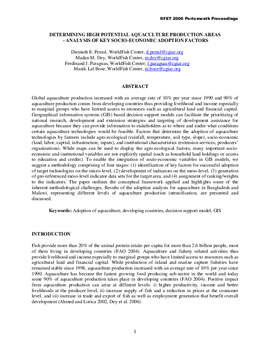Determining high potential aquaculture production areas: analysis of key socio-economic adoption factors

Citation
Pemsl, D.E. et al. (2006). Determining high potential aquaculture production areas: analysis of key socio-economic adoption factors. In Proceedings of the Thirteenth Biennial Conference of the IIFET, July 11-14, 2006, Portsmouth, UK: Rebuilding Fisheries in an Uncertain Environment. Compiled by Ann L Shriver. IIFET, Corvallis, Oragon, USA, 2006. CD ROM ISBN. 0-97632432-3-1
Global aquaculture production increased with an average rate of 10% per year since 1990 and 90% of aquaculture production comes from developing countries thus providing livelihood and income especially to marginal groups who have limited access to resources such as agricultural land and financial capital. Geographical information systems (GIS) based decision support models can facilitate the prioritizing of national research, development and extension strategies and targeting of development assistance for aquaculture because they can provide information to stakeholders as to where and under what conditions certain aquaculture technologies would be feasible. Factors that determine the adoption of aquaculture technologies by farmers include agro-ecological (rainfall, temperature, soil type, slope), socio-economic (land, labor, capital, infrastructure, inputs), and institutional characteristics (extension services, producers’ organizations). While maps can be used to display the agro-ecological factors, many important socioeconomic and institutional variables are not explicitly spatial (such as household land holdings or access to education and credits). To enable the integration of socio-economic variables in GIS models, we suggest a methodology comprising of four stages: (1) identification of key factors for successful adoption of target technologies on the micro-level, (2) development of indicators on the meso-level, (3) generation of geo-referenced meso-level indicator data sets for the target area, and (4) assignment of ranking/weights to the indicators. The paper outlines the conceptual framework applied and highlights some of the inherent methodological challenges. Results of the adoption analysis for aquaculture in Bangladesh and Malawi, representing different levels of aquaculture production intensification, are presented and discussed.
Permalink
Date Available
Type
Research Themes
Language